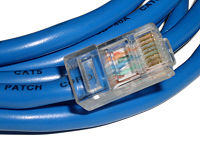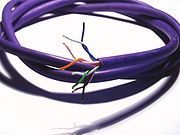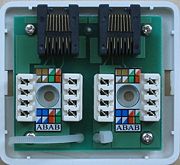
Category 5 cable
Encyclopedia

Twisted pair
Twisted pair cabling is a type of wiring in which two conductors are twisted together for the purposes of canceling out electromagnetic interference from external sources; for instance, electromagnetic radiation from unshielded twisted pair cables, and crosstalk between neighboring pairs...
cable for carrying signals. This type of cable is used in structured cabling
Structured cabling
Structured cabling is building or campus telecommunications cabling infrastructure that consists of a number of standardized smaller elements called subsystems.Structured cabling falls into six subsystems:...
for computer network
Computer network
A computer network, often simply referred to as a network, is a collection of hardware components and computers interconnected by communication channels that allow sharing of resources and information....
s such as Ethernet
Ethernet
Ethernet is a family of computer networking technologies for local area networks commercially introduced in 1980. Standardized in IEEE 802.3, Ethernet has largely replaced competing wired LAN technologies....
. It is also used to carry other signals such as telephony
Telephony
In telecommunications, telephony encompasses the general use of equipment to provide communication over distances, specifically by connecting telephones to each other....
and video
Video
Video is the technology of electronically capturing, recording, processing, storing, transmitting, and reconstructing a sequence of still images representing scenes in motion.- History :...
. The cable is commonly connected using punch down blocks and modular connector
Modular connector
Modular connector is the name given to a family of electrical connectors originally used in telephone wiring and now used for many other purposes. Many applications that originally used a bulkier, more expensive connector have now migrated to modular connectors...
s. Most Category 5 cables are unshielded
Electromagnetic shielding
Electromagnetic shielding is the process of reducing the electromagnetic field in a space by blocking the field with barriers made of conductive and/or magnetic materials. Shielding is typically applied to enclosures to isolate electrical devices from the 'outside world' and to cables to isolate...
, relying on the twisted pair design and differential signaling
Differential signaling
Differential signaling is a method of transmitting information electrically by means of two complementary signals sent on two separate wires. The technique can be used for both analog signaling, as in some audio systems, and digital signaling, as in RS-422, RS-485, Ethernet , PCI Express and USB...
for noise rejection. Category 5 has been superseded by the Category 5e specification.
|
||||||||||||||||||||||||||||||||||||
|
||||||||||||||||||||||||||||||||||||
 |
||||||||||||||||||||||||||||||||||||
 |
Cable standard
The specification for Category 5 cable was defined in ANSIAmerican National Standards Institute
The American National Standards Institute is a private non-profit organization that oversees the development of voluntary consensus standards for products, services, processes, systems, and personnel in the United States. The organization also coordinates U.S. standards with international...
/TIA/EIA-568-A, with clarification in TSB-95. These documents specified performance characteristics and test requirements for frequencies of up to 100 MHz. Cable types, connector types and cabling topologies are defined by TIA/EIA-568-B. The cable is terminated in either the T568A scheme or the T568B scheme. The two schemes work equally well and may be mixed in an installation so long as the same scheme is used on both ends of each cable. Nearly always, 8P8C modular connectors, often referred to as RJ45, are used for connecting category 5 cable. The USOC/RJ-61 standard is used in multi-line telephone connections.
Each of the four pairs in a Cat 5 cable has differing precise number of twists per metre based on prime numbers to minimize crosstalk between the pairs. On average there are 6 twists per 5 centimetres. Commonly seen are pairs are made from 24 and 28 gauge
American wire gauge
American wire gauge , also known as the Brown & Sharpe wire gauge, is a standardized wire gauge system used since 1857 predominantly in the United States and Canada for the diameters of round, solid, nonferrous, electrically conducting wire...
(AWG) copper wires within the cables. It is recommended that cable length above 16 feet(~4m) do not go for 28 AWG. Although cable assemblies containing 4 pairs are common, Category 5 is not limited to 4 pairs. Backbone applications involve using up to 100 pairs. This use of balanced line
Balanced line
In telecommunications and professional audio, a balanced line or balanced signal pair is a transmission line consisting of two conductors of the same type, each of which have equal impedances along their lengths and equal impedances to ground and to other circuits. The chief advantage of the...
s helps preserve a high signal-to-noise ratio despite interference from both external sources and crosstalk from other pairs. Category 5 cabling is most commonly used for faster Ethernet networks, such as 100BASE-TX and 1000BASE-T.
The cable is available in both stranded and solid conductor forms. The stranded form is more flexible and withstands more bending without breaking and is suited for reliable connections with insulation piercing connectors, but makes unreliable connections in insulation-displacement connector
Insulation-displacement connector
An Insulation-displacement connector, insulation-displacement technology/termination or insulation-piercing connector is an electrical connector designed to be connected to the conductor of an insulated wire or cable by a connection process which forces a selectively sharpened blade or blades...
s (IDCs). The solid form is less expensive and makes reliable connections into insulation displacement connectors, but makes unreliable connections in insulation piercing connectors. Taking these things into account, building wiring (for example, the wiring inside the wall that connects a wall socket to a central patch panel) is solid core, while patch cables (for example, the movable cable that plugs into the wall socket on one end and a computer on the other) are stranded. Outer insulation is typically PVC
Polyvinyl chloride
Polyvinyl chloride, commonly abbreviated PVC, is a thermoplastic polymer. It is a vinyl polymer constructed of repeating vinyl groups having one hydrogen replaced by chloride. Polyvinyl chloride is the third most widely produced plastic, after polyethylene and polypropylene. PVC is widely used in...
or LSOH
Low Smoke Zero Halogen
Low smoke zero halogen or low smoke free of halogen is a material classification typically used for cable jacketing in the wire and cable industry. LSZH cable jacketing is composed of thermoplastic or thermoset compounds that emit limited smoke and no halogen when exposed to high sources of...
. The specific category of cable in use can be identified by the printing on the side of the cable.
Conductors required
10BASE-T and 100BASE-TX Ethernet connections require two cable pairs. 1000BASE-T Ethernet connections require four cable pairs.Bending radius
Most Category 5 cables can be bent at any radius exceeding approximately four times the diameter of the cable.Maximum cable segment length
According to the ANSI/TIA/EIA standard for category 5e cable (TIA/EIA 568-5-A), the maximum length for a cable segment is 100 meters (328 feet). If longer runs are required, the use of active hardware such as a repeater, or a switch, is necessary. The specifications for 10BASE-T10BASE-T
Ethernet over twisted pair technologies use twisted-pair cables for the physical layer of an Ethernet computer network. Other Ethernet cable standards employ coaxial cable or optical fiber. Early versions developed in the 1980s included StarLAN followed by 10BASE-T. By the 1990s, fast, inexpensive...
networking specify a 100 metre length between active devices. This allows for 90 metres of fixed cabling, two connectors and two patch leads of 5 metres, one at each end.
Characteristics
| Property | Nominal Value | Tolerance | Unit | ref |
|---|---|---|---|
| Characteristic impedance Characteristic impedance The characteristic impedance or surge impedance of a uniform transmission line, usually written Z_0, is the ratio of the amplitudes of a single pair of voltage and current waves propagating along the line in the absence of reflections. The SI unit of characteristic impedance is the ohm... @ 100 MHz Hertz The hertz is the SI unit of frequency defined as the number of cycles per second of a periodic phenomenon. One of its most common uses is the description of the sine wave, particularly those used in radio and audio applications.... |
100 | ± 15 |
|-
|Nominal
Real versus nominal value
In economics, nominal value refers to a value expressed in money terms in a given year or series of years. By contrast, real value adjusts nominal value to remove effects of price changes over time...
characteristic impedance
Electrical impedance
Electrical impedance, or simply impedance, is the measure of the opposition that an electrical circuit presents to the passage of a current when a voltage is applied. In quantitative terms, it is the complex ratio of the voltage to the current in an alternating current circuit...
@ 100 MHz
Hertz
The hertz is the SI unit of frequency defined as the number of cycles per second of a periodic phenomenon. One of its most common uses is the description of the sine wave, particularly those used in radio and audio applications....
||align="right"|100||± 5||||
|-
|DC-Loop resistance||align="right"|≤ 0.188|| ||||
|-
|Propagation speed||align="right"|0.64|| ||c
Speed of light
The speed of light in vacuum, usually denoted by c, is a physical constant important in many areas of physics. Its value is 299,792,458 metres per second, a figure that is exact since the length of the metre is defined from this constant and the international standard for time...
||
|-
|Propagation delay||align="right"|4.80-5.30|| ||||
|-
|Delay skew < 100 MHz||align="right"|< 0.20|| ||||
|-
|Capacitance
Capacitance
In electromagnetism and electronics, capacitance is the ability of a capacitor to store energy in an electric field. Capacitance is also a measure of the amount of electric potential energy stored for a given electric potential. A common form of energy storage device is a parallel-plate capacitor...
at 800 Hz||align="right"|52|| ||||
|-
|Inductance
Inductance
In electromagnetism and electronics, inductance is the ability of an inductor to store energy in a magnetic field. Inductors generate an opposing voltage proportional to the rate of change in current in a circuit...
||align="right"|525|| ||||
|-
|Corner frequency||align="right"|≤ 57|| ||||
|-
|Max tensile load, during installation||align="right"|100|| ||||
|-
|Wire size||align="right"|AWG
American wire gauge
American wire gauge , also known as the Brown & Sharpe wire gauge, is a standardized wire gauge system used since 1857 predominantly in the United States and Canada for the diameters of round, solid, nonferrous, electrically conducting wire...
-24 || || ||
|-
|Insulation thickness||align="right"|0.245|| ||mm||
|-
|Maximum current per conductor||align="right"|0.577|| ||||
|-
|Temperature operating||align="right"|-55 to +60|| ||||
|}
Dielectric
| Acronym | Material |
|---|---|
| PVC | Polyvinyl Chloride Polyvinyl chloride Polyvinyl chloride, commonly abbreviated PVC, is a thermoplastic polymer. It is a vinyl polymer constructed of repeating vinyl groups having one hydrogen replaced by chloride. Polyvinyl chloride is the third most widely produced plastic, after polyethylene and polypropylene. PVC is widely used in... |
| PE | Polyethylene Polyethylene Polyethylene or polythene is the most widely used plastic, with an annual production of approximately 80 million metric tons... |
| FP | Foamed polyethylene |
| FEP | Teflon/fluorinated ethylene propylene |
| FFEP | Foamed Teflon/fluorinated ethylene propylene |
| AD/PE | Air dielectric/polyethylene |
Individual twist lengths
By altering the length of each twist, crosstalkCrosstalk (electronics)
In electronics, crosstalk is any phenomenon by which a signal transmitted on one circuit or channel of a transmission system creates an undesired effect in another circuit or channel...
is reduced, without affecting the characteristic impedance
Characteristic impedance
The characteristic impedance or surge impedance of a uniform transmission line, usually written Z_0, is the ratio of the amplitudes of a single pair of voltage and current waves propagating along the line in the absence of reflections. The SI unit of characteristic impedance is the ohm...
. The distance per twist is commonly referred to as pitch.
| Pair color | [cm] per turn | Turns per [m] | |
|---|---|---|---|
| Green | 1.53 | 65.2 | |
| Blue | 1.54 | 64.8 | |
| Orange | 1.78 | 56.2 | |
| Brown | 1.94 | 51.7 |
Environmental ratings
| Class | Phrase | Standards |
|---|---|---|
| CMP | Communications Plenum | CSA Canadian Standards Association The Canadian Standards Association, also known as the CSA, is a not-for-profit Standards organization with the stated aim of developing standards for use in 57 different areas of specialisation... FT7 or NFPA National Fire Protection Association The National Fire Protection Association is a United States trade association that creates and maintains private, copywrited, standards and codes for usage and adoption by local governments... 262 (UL Underwriters Laboratories Underwriters Laboratories Inc. is an independent product safety certification organization. Established in 1894, the company has its headquarters in Northbrook, Illinois. UL develops standards and test procedures for products, materials, components, assemblies, tools and equipment, chiefly dealing... 910) |
| CMR | Communications Riser | UL Underwriters Laboratories Underwriters Laboratories Inc. is an independent product safety certification organization. Established in 1894, the company has its headquarters in Northbrook, Illinois. UL develops standards and test procedures for products, materials, components, assemblies, tools and equipment, chiefly dealing... 1666 |
| CMG | Communications General purpose | CSA FT4 |
| CM | Communications | UL 1685 (UL 1581, Sec. 1160) Vertical-Tray |
| CMX | Communications Residential | UL 1581, Sec. 1080 (VW-1) |
| CMH | CSA FT1 |
CMR (Communications Riser), insulated with high-density polyolefin and jacketed with low-smoke polyvinyl chloride (PVC) can be replaced by a CMP (Communications Plenum), insulated with fluorinated ethylene propylene (FEP) and polyethylene (PE) and jacketed with low-smoke polyvinyl chloride (PVC), due to better flame test ratings. CM (Communications) is insulated with high-density polyolefin, but not jacketed with PVC and therefore is the lowest of the three in flame resistance.
Some cables are "UV-rated" or "UV-stable" meaning they can be exposed to outdoor UV
Ultraviolet
Ultraviolet light is electromagnetic radiation with a wavelength shorter than that of visible light, but longer than X-rays, in the range 10 nm to 400 nm, and energies from 3 eV to 124 eV...
radiation without significant destruction. The materials used for the mantle are usually PVC
Polyvinyl chloride
Polyvinyl chloride, commonly abbreviated PVC, is a thermoplastic polymer. It is a vinyl polymer constructed of repeating vinyl groups having one hydrogen replaced by chloride. Polyvinyl chloride is the third most widely produced plastic, after polyethylene and polypropylene. PVC is widely used in...
.
Any cable that contains air spaces can breathe in moisture, especially if the cable runs between indoor and outdoor spaces. Warm moist air can cause condensation inside the colder parts of the cable outdoors. It may be necessary to take precautions such as sealing the ends of the cables. Some cables are suitable for "direct burial", but this usually requires that the cable be gel filled in order to hinder moisture migration into the cable.
When using a cable for a tower
Radio masts and towers
Radio masts and towers are, typically, tall structures designed to support antennas for telecommunications and broadcasting, including television. They are among the tallest man-made structures...
, attention must be given to vertical cable runs that may channel water into sensitive indoor equipment. This can often be solved by adding a drip-loop at the bottom of the run of cable.
Plenum-rated cables are slower to burn and produce less smoke than cables using a mantle of materials like PVC. This also affects legal requirements for a fire sprinkler system. That is if a plenum-rated cable is used, sprinkler requirement may be eliminated.
Shielded cables (FTP/STP) are useful for environments where proximity to power cables or RF equipment
Radio frequency
Radio frequency is a rate of oscillation in the range of about 3 kHz to 300 GHz, which corresponds to the frequency of radio waves, and the alternating currents which carry radio signals...
, may introduce electromagnetic interference
Electromagnetic interference
Electromagnetic interference is disturbance that affects an electrical circuit due to either electromagnetic induction or electromagnetic radiation emitted from an external source. The disturbance may interrupt, obstruct, or otherwise degrade or limit the effective performance of the circuit...
, and can also be used where eavesdropping
Eavesdropping
Eavesdropping is the act of secretly listening to the private conversation of others without their consent, as defined by Black's Law Dictionary...
likelihood should be minimized.
See also
- American wire gaugeAmerican wire gaugeAmerican wire gauge , also known as the Brown & Sharpe wire gauge, is a standardized wire gauge system used since 1857 predominantly in the United States and Canada for the diameters of round, solid, nonferrous, electrically conducting wire...
(AWG) - Audio over EthernetAudio over EthernetIn audio engineering and broadcast engineering, Audio over Ethernet is the use of an Ethernet-based network to distribute real-time digital audio....
(AoE) - Ethernet over twisted pairEthernet over twisted pairEthernet over twisted pair technologies use twisted-pair cables for the physical layer of an Ethernet computer network. Other Ethernet cable standards employ coaxial cable or optical fiber. Early versions developed in the 1980s included StarLAN followed by 10BASE-T. By the 1990s, fast, inexpensive...
(10/100/1000Base-T) - Power over EthernetPower over EthernetPower over Ethernet or PoE technology describes a system to pass electrical power safely, along with data, on Ethernet cabling. The IEEE standard for PoE requires category 5 cable or higher for high power levels, but can operate with category 3 cable for low power levels...
(PoE)









